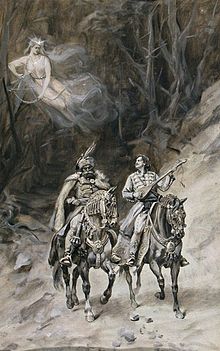Our website is made possible by displaying online advertisements to our visitors.
Please consider supporting us by disabling your ad blocker.
Vila (fairy)
This article needs additional citations for verification. (May 2021) |

A vila, or víla [ˈviːla] (plural: vile, or víly [ˈviːli]; Bulgarian: vila, diva, juda, samovila, samodiva, samojuda; Czech: víla, samodiva, divoženka; Old East Slavic: vila; Polish: wiła; Serbo-Croatian: vila; Slovak: víla; Slovene: vila)[1] is a Slavic fairy similar to a nymph.
The vila is mostly known among South Slavs; however, some variants are present in the mythology of West Slavs as well. Among Czechs, víla denotes a woodland spirit (15th century), and ancient place names such as Vilice near Tábor, Vilov near Domažlice, and Vilín near Sedlčany seem to indicate that she was known there as well.[2] In the Chronicle of Dalimil (3, 53) vila is "fool" (as in Old Polish). In Russia, vile are mentioned in the 11th century, but there is doubt that they were truly a part of Russian folklore, and not just a literary tradition. There are common traits between the vile and the rusalki, and Schneeweis holds that they are identical.
Previous Page Next Page


